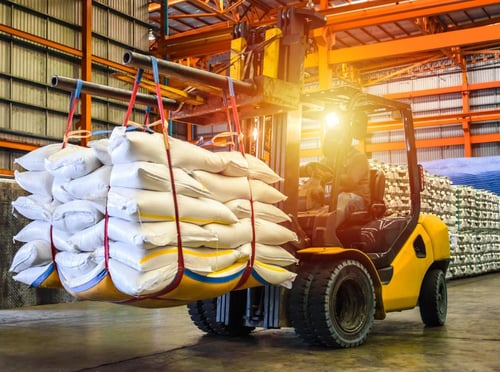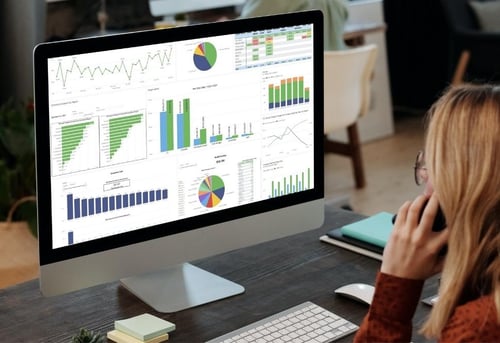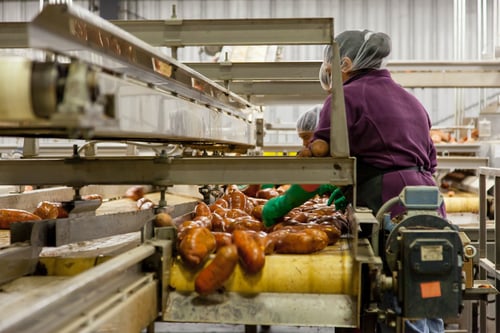The food and beverage industry is a melting pot of transformation. For many businesses, improved logistics will be the secret sauce of success.
The food and beverage industry is as diverse as it is volatile. While some enterprises in the space have been deeply scarred by the COVID-19 pandemic, others have benefited from a groundswell of consumer demand. In early 2022, the industry is closely watching (and spicily debating) society’s evolving attitude to the What, How, and Where of food.
Industry overview
-
The US food and beverage manufacturing industry employed nearly 1.7 million people in 2021, according to the US Bureau of Labor Statistics.
-
The global food and beverages market is projected to increase from around $6.1 billion in 2020 to over $7.5 billion by 2023, according to a 2020 ResearchAndMarket.com market analysis.
-
The US online grocery market alone is expected to grow from $113 billion in 2020 to $307 billion by 2027, according to MarketResearch.com.
 In this rapidly expanding marketplace, expectations among consumers for faster order fulfillment and a wider range of choices will continue to stretch the limits of the US food and beverage supply chain.
In this rapidly expanding marketplace, expectations among consumers for faster order fulfillment and a wider range of choices will continue to stretch the limits of the US food and beverage supply chain.
Additionally, the food and drink sector is beset with spiraling inflationary pressures and a trucking industry crippled by Covid19 and The Great Resignation. The overall price of food products rose by close to 5% from 2020 to 2021, Food Processing Magazine reports, with prices on meat (the main cost ingredient for restauranteurs) escalating by up to 25%. The industry as a whole faces significant supply chain and labor shortage challenges, at least for the foreseeable future.
Challenges
Impacted by chronic staff shortages and rising freight costs, the food and beverage industry is not the Swiss watch of logistics it once was. In the face of growing uncertainty, businesses are building more robust and risk-averse supply chain methodologies.
Worker shortages
To move products efficiently across the US, food and beverage manufacturers are reliant on a widely dispersed workforce of consumer packaged goods employees. At the end of 2021, this workforce is a shadow of what it should be, with over 130,000 vacant jobs according to the most recent Consumer Brands Association estimate. “We are experiencing a supply chain crisis unlike anything our industry has seen before and the labor shortage is at the top of our list of concerns,” CBA’s CEO, Geoff Freeman, said in an article for industry periodical, Powder & Bulk Solids Magazine.
As the industry struggles to play catch up — with a smorgasbord of strategies including automated production technologies, improved retention strategies, and a concerted recruitment drive to attract new talent — it’s left to food manufacturers and supporting freight providers to keep going as best they can. For now, the problem of too few chefs in the kitchen isn’t going anywhere.
Rising freight costs
The American Trucking Association estimates that the trucking industry is approximately 80,000 workers shy of the workforce it needs to operate at even minimal efficiency. Moreover, that problem does not appear to be a structural workforce issue that market forces can swiftly resolve. In fact, The ATA’s latest work fall projections indicate the shortfall may double by 2030.
The shortfall looks set to continue contributing to the industry’s rising rate environment. Rate increases at the end of 2021 for parcel/ground, LTL, and Truckload averaged between 4.9% and 8.9%, IL2000’s 2022 January update reports.
On-time delivery
 Pervasive shortages of foods since the beginning of the COVID pandemic underscore the remarkable fragility of the US food supply chain. The pursuit of the Just In Time (JIT) supply chain model has been discarded by the food and beverage industry in favor of maintaining a stockpiled inventory as a buffer against uncertainty.
Pervasive shortages of foods since the beginning of the COVID pandemic underscore the remarkable fragility of the US food supply chain. The pursuit of the Just In Time (JIT) supply chain model has been discarded by the food and beverage industry in favor of maintaining a stockpiled inventory as a buffer against uncertainty.
Delivery uncertainties mean enterprises have to pivot back to more warehouse stockpiling, longer lead times when planning inbound freight, and harder to accommodate demands for outbound freight.
Emerging developments
Consumer demand is changing. The Covid-19 pandemic has fundamentally changed how consumers are spending their money, and it appears that many of these changes will be permanent. Society’s changing food preferences are likely to continue to exert a profound impact on the food and beverage industries for the foreseeable future.
The shift away from restaurants to home cooking
 Restaurant services suffered during the pandemic. While demand has returned, it appears likely that the pandemic prompted a more permanent cultural shift toward cooking and eating at home.
Restaurant services suffered during the pandemic. While demand has returned, it appears likely that the pandemic prompted a more permanent cultural shift toward cooking and eating at home.
Around 86% of meals eaten in the US are prepared at home, according to market research firm, NPD Group. Restaurant meals, meanwhile, are at their lowest point in close to 30 years.
That transformation of consumer preference hasn’t just altered the final destination of food products from restaurants to dwellings; it has also changed what kinds of foods consumers are buying. Demand for canned and jar foods was in significant decline prior to COVID. That trend has now reversed, Food Processing Magazine reports in its 2021 Food and Beverage industry outlook. Canned soup sales doubled in 2021. Frozen meals were up by 40%. The changing lineup of products is trickling right through the supply chain. Carriers are being challenged to deal with new routes, different timelines, and an evolving regulatory environment.
Growing demand for food transparency
“52% of all recalls cost over $10M and 23% cost over $30M. The food supply chain today is truly a maze that is global, dynamic, and complex in nature.” (Food Safety Magazine, The Importance of Food Traceability.)
 The industry is already beginning to see the far-reaching consequences of household consumers building a closer relationship with food. For example, the industry is observing growing regulatory pressure to improve “food transparency” — the information provided with food to reassure consumers that they are getting what they paid for. Research commissioned by the Food Industry Association reveals the leading edge of that trend; a 2020 consumer survey found that over 80% of shoppers want more information about where their food came from.
The industry is already beginning to see the far-reaching consequences of household consumers building a closer relationship with food. For example, the industry is observing growing regulatory pressure to improve “food transparency” — the information provided with food to reassure consumers that they are getting what they paid for. Research commissioned by the Food Industry Association reveals the leading edge of that trend; a 2020 consumer survey found that over 80% of shoppers want more information about where their food came from.
Supply chains will need to continue to adapt to these shifting preferences, not just in terms of what is shipped and where it goes, but also how it reached its destination. Carriers may come under more pressure to furnish their clients with more full “freight transparency” to allay the concerns of consumers.
New kinds of food
Cultured meat still faces daunting regulatory hurdles before products hit the market for consumption. But in 2021, over 80 startups were aggressively investing in cultured meat products, the Institute of Food Technologists reports. With over $800 million already invested in developing cultured meat products, more than a few food industry pundits are forecasting a rapid path from proof-of-concept to a marketable product. What this means for the vast supply chain infrastructure surrounding meat processing remains an unknown, but we’ll likely see some level of industry disruption in the coming years.
Solutions
While business-specific solutions may be as varied as food itself, three broad strategies have far-reaching significance across the industry: improved systems, better data, and outsourcing carrier management.
Transport management systems
Until quite recently, businesses in the food and beverage space could operate effectively with a simple supply chain. A small list of carriers and a straightforward operating approach were all it took to secure your inbound and outbound shipping. As the changing face of the food and business sector reveals, the luxury of simplicity is rapidly disappearing. The market is too deeply interconnected, and far too beset with long-term structural vulnerabilities.
With the world rapidly changing, food and beverage enterprises are turning to 3PL transportation management systems to acquire a more robust approach to risk management. IL2000’s TMS equips clients to quickly and accurately manage the day-to-day tasks of their supply chain, such as acquiring quotes, booking shipments, and generating documentation. The IL2000 TMS also allows a business to track shipments in real-time, greatly enhancing its agility to pivot when dealing with unanticipated complications.
Business intelligence dashboards
 Rising costs are challenging shippers to devise more sophisticated and granular freight operations. Access to data and careful analysis of historical trends are becoming increasingly critical as companies compete to secure a cost-efficient and reliable supply chain. In this steady march toward working smarter, historical shipment data plays a particularly crucial role:
Rising costs are challenging shippers to devise more sophisticated and granular freight operations. Access to data and careful analysis of historical trends are becoming increasingly critical as companies compete to secure a cost-efficient and reliable supply chain. In this steady march toward working smarter, historical shipment data plays a particularly crucial role:
“Shippers and 3PL’s should use historical shipment data to identify consistent and repeatable activity. By identifying these lanes, 3PL’s can approach carriers regardless of mode to “contract” for capacity, which increases control as well as protects against surging transportation costs.” (IL2000 January 2022 LTL and Truckload Monthly Market Update.)
Business intelligence dashboards provide these and similar data sets to help shippers tame the complexity of a volatile freight market. IL2000 specializes in developing deeply customized BI dashboards that support clarity of supply chain thinking across a company’s whole decision-making structure.
Carrier management
Food and beverage businesses are either scrambling to secure reliable suppliers or are scrambling to deliver that same reliability to someone else. Most will be trying to make both happen at once. An increasing number of companies in this position are turning to a 3PL to manage carriers – or even a dedicated fleet of vehicles – on their behalf.
A 3PL’s support may be particularly vital for enterprises that rely on a complex supply chain, such as those requiring refrigeration or specialized handling throughout transit. The more fragile and time-sensitive a shipment, the greater the impact of a consistent fleet run by well-trained drivers will be. Skilled 3PL carrier management may represent the difference between commercial success and failure.
Looking for a recipe for success in the food and beverage supply chain?
The food and beverage industry in 2022 presents enormous opportunities — filled with new market areas, rapid growth, and remarkable innovation. But alongside the potential simmer significant production and supply chain challenges, some with no obvious solution in sight. Businesses in the space will need to achieve new heights of logistics efficiency in order to survive and thrive.
If your business is searching for a secret recipe for supply chain success, talk to the team at IL2000. With decades of experience in freight operations, we brew better supply chain decisions.


